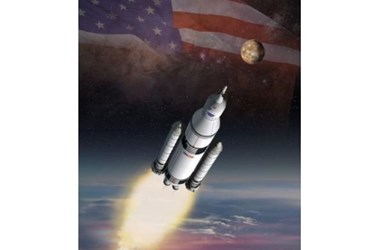NASA And ATK Complete Avionics And Controls Testing For NASA's SLS Booster

ATK Achieves Significant Milestone as Booster Integrator
Arlington, VA /PRNewswire/ -- NASA and ATK (NYSE: ATK) have successfully completed two key avionics tests for the solid rocket boosters for the space agency's new heavy lift rocket, the Space Launch System (SLS), being constructed to embark on bold missions to explore deep space.
The avionics tests, called hot fires, operate the booster's thrust vector control (TVC) system as if the booster were actually launching the SLS on a mission. The tests were conducted at ATK's Promontory, Utah, facility and represent a significant milestone as well as validation of SLS cost-saving efforts. As booster integrator, ATK has diligently focused on cost improvements for NASA's deep space exploration program to deliver affordable innovation.
"ATK has integrated value stream efficiencies across our SLS booster supply chain to achieve significant cost improvements," said Charlie Precourt, vice president and general manager of ATK's Space Launch division. "As such, we have been able to design, develop, test and streamline operations as we prepare for the first launch in 2017."
The new, advanced avionics system is a critical aspect of the twin SLS boosters, providing power distribution, communication with the flight computers, booster ignition, command and control of the booster steering system and booster staging. The tests simulated SLS launch sequences both in preflight checks and in an ascent profile by verifying communication between ground and flight systems, starting motor ignition and moving the TVC system. The successful testing validated the new SLS booster avionics subsystem and electronic support equipment (ESE).
Training and evaluating the test team was an additional component of the test as team members were subjected to a variety of atypical conditions during simulated countdowns and firings. People, processes and tools were evaluated to strengthen and enhance performance at launch.
"Knowledge transfer is one of the most critical aspects of the avionics test and one of the most rewarding," said Precourt. "It's inspiring to see our early career employees train on this modernized system, armed with knowledge passed on to them by our world-class Space Shuttle team."
Other test objectives included validating the new electronic support equipment that replaced heritage ground equipment. Much of the equipment replaced was designed and built during the mid- to late-1970s and was successfully used on all 53 of the Space Shuttle Reusable Solid Rocket Motor and three 5-segment development motors static motor firings. The innovative equipment demonstrated in these tests dramatically reduces cost and increases reliability of the booster system.
ATK developed the avionics subsystem and ESE at its facilities in Clearfield and Magna, Utah, with support from NASA Marshall Space Flight Center in Alabama. Key partners supported ATK throughout this test series, including L-3 Cincinnati Electronics inMason, Ohio, and Southern California Braiding, an IEC Electronics Company in Bell Gardens, Calif.
Cincinnati Electronics provides the avionics systems and boxes, and Southern California Braiding is responsible for the cable harnesses. Both suppliers have been integral to ATK throughout the development lifecycle of the SLS booster.
"Our suppliers are extremely important to the success of the SLS booster program," said Precourt. "Their dedication to ensuring safety for human spaceflight is commendable."
ATK is an aerospace, defense and commercial products company with operations in 22 states, Puerto Rico and internationally. News and information can be found on the Internet at www.atk.com, on Facebook at www.facebook.com/atk or on Twitter @ATK.
Certain information discussed in this press release constitutes forward-looking statements as defined in the Private Securities Litigation Reform Act of 1995. Although ATK believes that the expectations reflected in such forward-looking statements are based on reasonable assumptions, it can give no assurance that its expectations will be achieved. Forward-looking information is subject to certain risks, trends and uncertainties that could cause actual results to differ materially from those projected. Among those factors are: changes in governmental spending, budgetary policies and product sourcing strategies; the company's competitive environment; the terms and timing of awards and contracts; and economic conditions. ATK undertakes no obligation to update any forward-looking statements. For further information on factors that could impact ATK, and statements contained herein, please refer to ATK's most recent Annual Report on Form 10-K and any subsequent quarterly reports on Form 10-Q and current reports on Form 8-K filed with the U.S. Securities and Exchange Commission.
Source: ATK
Copyright 2013 PR Newswire. All Rights Reserved